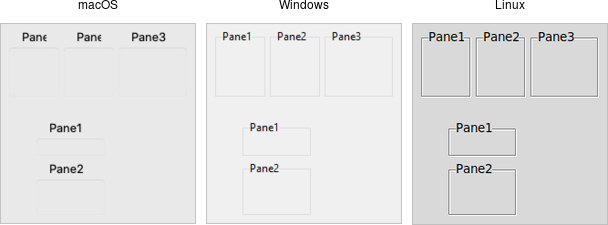Paned Windows
A panedwindow widget lets you stack two or more resizable widgets above and below each other (or to the left and right). Users can adjust the relative heights (or widths) of each pane by dragging a sash located between them. Typically the widgets you're adding to a panedwindow will be frames containing many other widgets.
| Panedwindow widgets(shown here managing several labelframes) |
|---|
 |
Panedwindows are created using the add_ttk_panedwindow method:
// cargo run --example paned_windows use tk::*; use tk::cmd::*; fn main() -> TkResult<()> { let tk = make_tk!()?; let root = tk.root(); let p = root.add_ttk_panedwindow( -orient("vertical") )?.pack(())?; // two panes, each of which would get widgets gridded into it: let f1 = p.add_ttk_labelframe( -text("Pane1") -width(100) -height(100) )?; let f2 = p.add_ttk_labelframe( -text("Pane2") -width(100) -height(100) )?; p.add( &f1, () )?; p.add( &f2, () )?; Ok( main_loop() ) }
A panedwindow is either vertical (its panes are stacked vertically on top of
each other) or horizontal. Importantly, each pane you add to the panedwindow
must be a direct child of the panedwindow itself.
Calling the add method adds a new pane at the end of the list of panes. The
insert( position, subwindow, options ) method allows you to place the pane at
the given position in the list of panes (0..n-1). If the pane is already managed
by the panedwindow, it will be moved to the new position. You can use the
forget( subwindow ) to remove a pane from the panedwindow (you can also pass a
position instead of a subwindow).
You can assign relative weights to each pane so that if the overall panedwindow resizes, certain panes will be allocated more space than others. As well, you can adjust the position of each sash between items in the panedwindow. See the command reference for details.